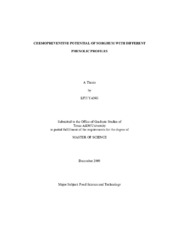| dc.description.abstract | Epidemiological evidence has correlated consumption of sorghum with reduced
incidences of gastrointestinal (GI) tract cancer, especially esophageal cancer. There is
little evidence on how phenols of sorghum may affect chemoprevention. Seventeen
sorghum varieties were screened for phenolic profiles and antioxidant capacity. The
ability of crude sorghum extracts to induce NAD(P)H:quinone oxidoreductase (QR, a
phase II protective enzyme), and inhibit proliferation of colon (HT-29) and esophageal
(OE33) carcinoma cells using the MTT (3-(4,5-dimethylthiazol-2-yl)-2,5-
diphenyltetrazolium bromide) and PicoGreen assays, were determined in vitro. 3-
Deoxyanthocyanidins, apigeninidin, luteolinidin and their methoxylated derivatives were
also investigated for antioxidant capacity, QR inducing and antiproliferative potential.
Tannin sorghum generally showed higher antioxidant capacity than non-tannin
sorghum varieties. Sorghum varieties containing extractable condensed tannins did not
show any significant QR inducing potential; on the other hand, non-tannin sorghums
increased QR activity by 1.5-2.7 times; black sorghum (Tx430) was most potent
(doubled QR activity at 25 mg/mL, 2.7-fold increase at 100 mg/mL). All sorghum extracts showed relatively strong antiproliferation activity with IC50s (the concentration
needed to inhibit cancer cell growth by 50%) of 49.7-883 mg/mL. Tannin-containing
sorghums had stronger cancer cell proliferation inhibitory potential (IC50s 49.7-131
mg/mL) than non-tannin sorghums (IC50s 141-883 mg/mL). Total phenol content and
antioxidant capacity of crude sorghum extracts positively correlated with their
antiproliferative potential (r2 0.71-0.97).
Among tested 3-deoxyanthocyanidins, methoxylation on A-ring improved QR
inducing potency. 5,7-Dimethoxyluteolinidin had the greatest QR inducing potency (4.3-
fold at 100 mM). Methoxylation also improved their antiproliferation potential; the IC50s
trend was di-methoxylated (8.3-105 mM) > mono-methoxylated (40.1-192 mM) >
apigeninidin and luteolinidin (81.5-284 mM).
This study provides information for how phenolic compositions of sorghum and
3-deoxyanthocyanidin structure affect their capacity to induce QR activity and inhibit GI
tract cancer cell proliferation. The information is useful to promote the utilization of
sorghum in functional foods, beverages, dietary supplements, and other health-related
industries. Further study will focus on, fractioned and isolated sorghum phenols, the
effect of food processing on their chemopreventive potential, as well as cellular
mechanisms involved. | en |


